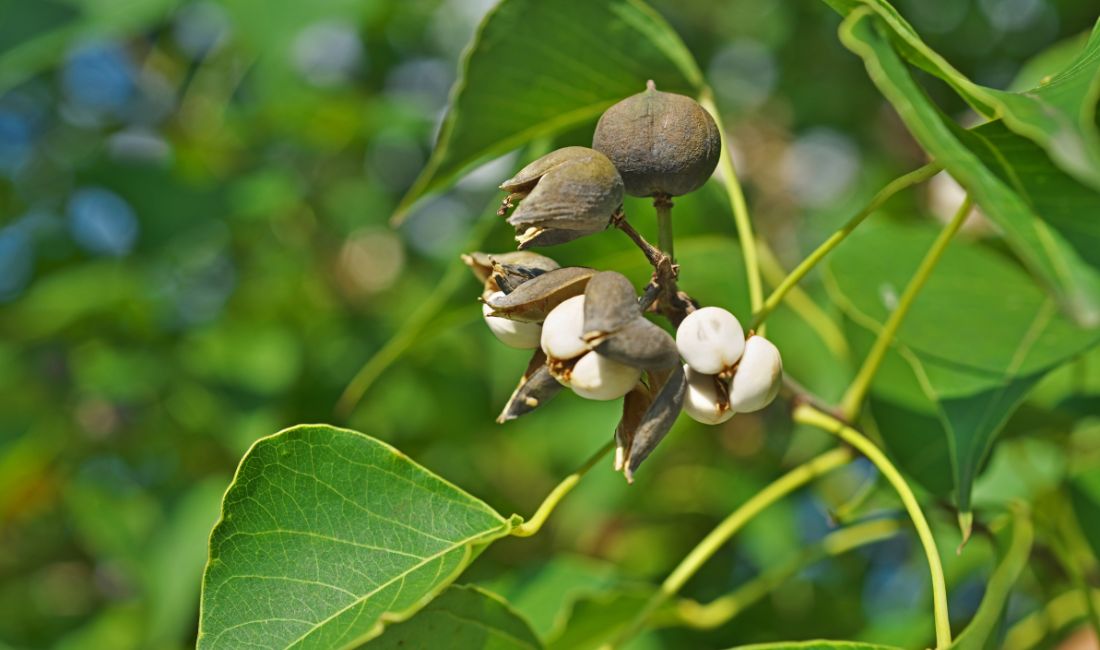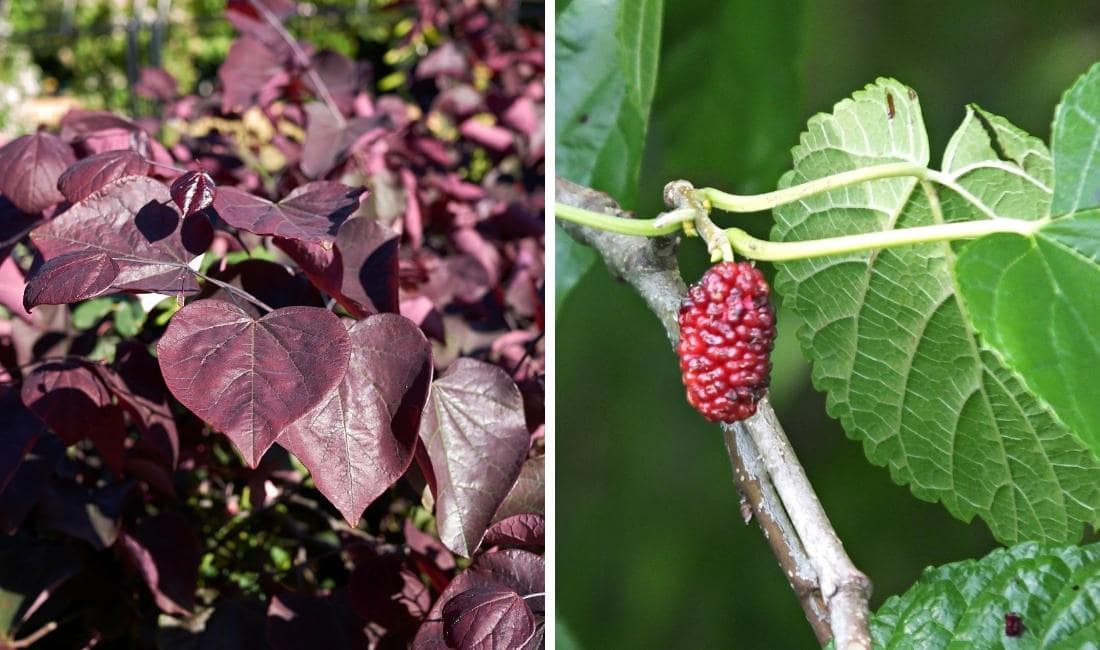It is a plant with red, almost heart-shaped leaves, the fun nickname of “popcorn tree,” and was mentioned in a letter by Benjamin Franklin. With all of that in its favor, how could Chinese tallow possibly be bad for your Palm Beach property?
In many ways, it turns out.
In this article, we will go over the details of Chinese Tallow, an invasive plant and noxious weed that is prohibited from being planted, sold, or grown in Florida yet can be found in many South Florida properties, causing issues.

How to Recognize the Chinese Tallow Tree
Chinese Tallow (Triadica sebifera, previously Sapium sebiferum) was a popular landscape tree that can still be found on South Florida properties today, but thanks to its rapid spread and a propensity to take over Florida’s natural areas, it has been labeled invasive and placed on the list of prohibited plants.
Leaves
Chinese tallow has waxy green leaves that turn red, orange, or yellow in the fall and then fall to the ground. The leaves are similar to aspen leaves – rounded on the top and then taper to a point, which can resemble a kite or, occasionally, a heart. The leaves grow alternately on each branch.
Size and shape
Chinese tallow trees typically grow to around 30 feet in our area, making it a small to medium-sized trees. In some areas, it has been observed to grow as much as 60 feet tall. The trunk is often gray with vertical cracks. You may notice new growth on the tree as early as February. Flowers appear from March through May, and the leaves will change color in the fall, which is unusual for many trees that grow in Florida.
Flowers and Seeds
Small yellow flowers appear clustered together in a pod-like form (called a catkin) in spring, followed by the fruit, a 3-lobed capsule that turns brown. Inside the capsule are three white seeds that some say resemble popcorn, which is why some refer to Chinese tallow as the popcorn tree.
One distinctive characteristic of the Chinese tallow tree is that it has milky sap. If you break a leaf (or any other part of the tree) open and see a white liquid, that is the milky sap. Most trees that resemble Chinese tallow do not have this white liquid.

How Did Chinese Tallow Arrive in Florida?
We may not know the exact route it took to get here, but Chinese tallow has been known to be in the United States since the 1700s. In fact, Benjamin Franklin even sent some Chinese tallow seeds to a friend in what was then the Georgia colony in 1772.
It was grown as an ornamental tree and was intended to be cultivated for seed oil that would be used in the production of soap. In its native China, it is grown for the production of oil and for manufacturing candles, soap, and fuel.
Some refer to the Chinese tallow as Florida aspen, though it is not an aspen tree. It is commonly found in Florida’s roadside ditches as well as in coastal areas and near streams and rivers. Due to its rapid growth and uncontrolled spread, the trees can often form a dense thicket, blocking sunlight from native plants and taking over.
Chinese tallow was originally thought of as “easy to grow” due to its ability to grow in many types of soil, sun exposure, and weather conditions. Its colorful foliage, small-to-medium size, and lack of insect pest issues were all considered positive aspects.
Chinese Tallow’s Invasiveness
Chinese tallow has become invasive in the U.S. thanks to its ability to reproduce rapidly and abundantly. Within just three years, a Chinese tallow tree can start producing seeds. A single mature tree can produce 100,000 viable seeds annually. These seeds are spread by birds and flowing water, and each seed can last up to five years!
Chinese tallow trees can also spread by root sprouts or cuttings, which means that if you cut a Chinese tallow tree down, it may sprout up again. Some Chinese tallow trees can live for up to 100 years, so imagine how many seeds are produced during that time.
Because Chinese tallow is not native to the United States, it has few, if any, predators. Many of our native pests stay away from Chinese tallow trees due to the poisonous qualities of the leaves and fruit. In its native China and Taiwan, there are bugs that will control the spread of this tree; here there is nothing to stop it from growing and spreading to new locations.
Chinese tallow can withstand drought conditions, so even if they aren’t receiving enough rain, they tend to thrive. This is partly because this type of tree can often have a deep taproot that is able to find sources of water deep in the ground.

The seed pods of Chinese tallow trees start out green (top pod), mature to a brown color (pod on the right), and eventually crack open to reveal the seeds (pod on the left).
Nonnative Plants and Trees Can Negatively Impact Wildlife
While a few birds seem to be able to eat the seeds of the Chinese tallow tree, there are few benefits for Florida wildlife. In fact, since the Chinese tallow tree becomes overgrown and crowds out native species of plants and trees, some animals’ food sources have become scarce.
There have even been studies on how Chinese tallow leaves have negatively affected frogs. Many tadpoles that were exposed to tallow leaves died or, in another study, exposure to the leaves caused premature hatching of frog eggs.
State of Florida Noxious Weed List
Like many invasive plants, Chinese tallow grows so well in our South Florida climate that it has begun to take over many areas, choking out our native trees and plants and destroying ecosystems that our local wildlife rely on for shelter and food.
Chinese tallow was placed on the State of Florida Noxious Weed List in 1998.
It was included on the 1993 list of Florida’s most invasive species by the Florida Invasive Species Council.
Its current status is Prohibited, meaning that it is illegal to possess with the intention of selling, transporting, or planting.

How to remove Chinese Tallow from Your Palm Beach Property
If you spot Chinese tallow trees anywhere on your property, you should remove it as soon as possible. If still small, you may be able to pull the whole tree, roots and all, from the ground.
Chinese tallow trees can also be removed by a professional. They should be cut by a chainsaw as close to the ground as possible. Since Chinese tallow can resprout, the remaining stump should be treated with an herbicide to prevent new growth. Alternatively, you can remove any new growth as it sprouts, though this may become an ongoing task.
The seeds from Chinese tallow trees should also be removed and disposed of to prevent any new seedlings.
What are some alternatives to plant instead of Chinese Tallow?
While at first glance, the Chinese tallow tree seems like a great mid-sized ornamental tree, the problems it causes are too extensive for us to recommend that you keep it on your property. Instead, try these similar native trees:
Eastern Redbud (Cercis canadensis)
Eastern redbud can reach 20 to 30 feet and is known for its spring pink or white flowers. Like Chinese tallow, it has leaves that are sometimes described as heart-shaped and have colorful fall foliage that turns either yellow, bronze, or burgundy.
Red Mulberry (Morus rubra)
Red mulberry is a native tree that can reach 40 feet and, while it doesn’t do well with salt spray, can thrive on Palm Beach properties if it is shielded from the coastal winds by other trees. Birds and humans enjoy the fruit in April and May. This tree also loses its leaves in the fall and can be a fast-growing shade tree.

Coastal Gardens Can Help
If you haven’t come across a Chinese tallow tree in your Palm Beach yard, you’re sure to soon. Knowing what they look like and how harmful they are can prevent more issues and more infestations. Be sure that anyone who works or spends time on your property is familiar with Florida’s invasive species and what to do if they encounter any.
At Coastal Gardens, we are always on the lookout for noxious weeds, invasive plants, or any other issues that may arise on your Palm Beach property. You can trust us to remove and/or control any invasive species before they become a problem.
CALL US TODAY At 561-308-7604
Estate landscape Services
For Fine Properties in Palm Beach
With Coastal Gardens, you can rest easy knowing that your property is taken care of by a dedicated team of estate landscape professionals who truly care about creating and maintaining a dazzling outdoor space you can be proud of.
